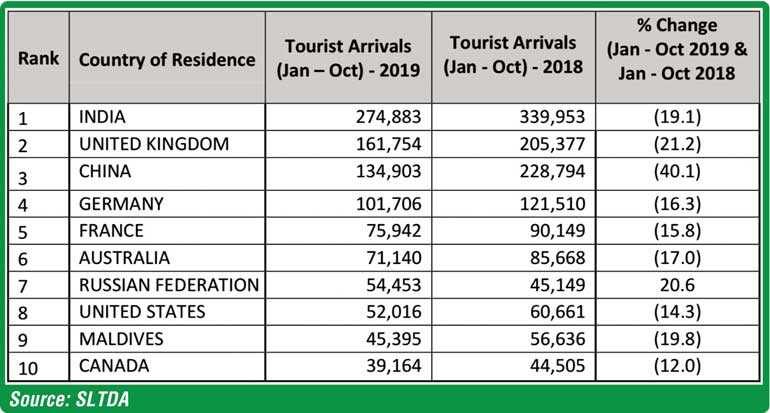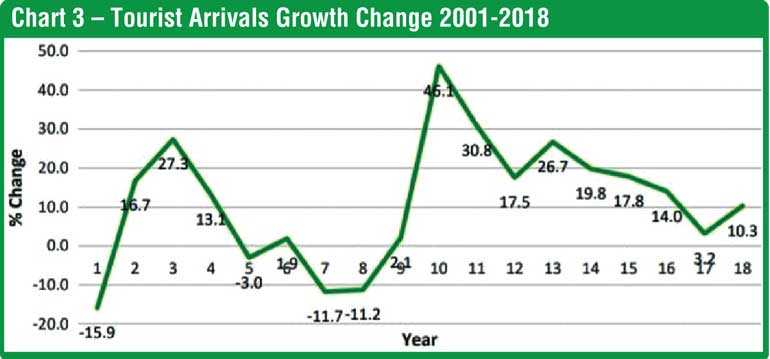Monday Jan 19, 2026
Monday Jan 19, 2026
Tuesday, 3 December 2019 00:32 - - {{hitsCtrl.values.hits}}


It took a lot of thought before I decided to put pen to paper. Whilst the key industry stakeholders like THASL and SLAITO have raised the red flag on the industry with almost 70 hotels up for sale, in my view we have got the fourth chance to make Sri Lanka tourism a world-beater given that ‘export status’ declared by the seventh President of Sri Lanka.
Incidentally this has been a proposal by the industry for so many years but had fallen on deaf ears. We need to congratulate the new Government for taking this strategic decision. The industry hails the move and the tax breaks that come with it.

Yahapalanaya ruined the industry
Let’s not mince words, the truth is that the Yahapalanaya Government ruined the industry with absolute poor direction. In just four years, the Sri Lanka Tourism Promotion Bureau (SLTPB) had six chairmen. To be specific since 2015 – Rohantha Athukorala, Paddy Withana, Udaya Nanayakkara, Dehan Seneviratne, Janaka Sugathadasa and then Kishu Gomes. This in itself sends a signal to the industry on the lackadaisical mindset that existed.
A sister organisation like the Sri Lanka Export Development Board had one chairperson right across the tenure from 2015-2019 and Sri Lanka saw the benefits from the consistency. But sadly, the policymakers very clearly had other plans which is why the changing appointments of the implementers.
The industry was very clear on their call, all they wanted from SLTPB was to launch the global marketing campaign which was spelled out by THASL Chairman Sanath Ukwatte at the AGM 2019, which the Yahapalanaya Government had failed miserably.
The market – $ 5.3 trillion
Let me give a snapshot on how attractive this industry is. The global tourism industry is worth $ 5.3 trillion growing at 8% for the last seven years with almost 319 million jobs contributing to 10.4% of GDP. Sri Lanka with 2,400 hotels and a hotel room stock of 39,000 has 32 airlines operating into the Sri Lankan market. Average room rates are at 10.8 room nights hence in total Sri Lanka market share will be 3.7%
First chance: 2009
If I track back, in 2009 we got the first chance after the cessation of hostilities with the LTTE. A fully-fledged advertising tender was rolled out, with top professionals in the technical committee. After a rigorous process that lasted almost a year, we selected a global advertising agency, and for each market a specialised PR agency that included a research agency to support the decision making.
The process was headed by one of the top professionals in the industry, Dileep Mudadeniya. But alas, on the day of the launch of ‘Sri Lanka – the Small Miracle,’ it was cancelled while the guests were gathered at the BMICH awaiting the arrival of the Chief Guest. The logic was: ‘Sri Lanka has beaten the LTTE and it is not a small miracle but a BIG miracle.’ A very sad day for Sri Lanka Tourism, given that the whole process was managed very professionally, and decisions taken on merit with strong research backing.
Second chance: 2015
Then came the second chance in 2015, when the Yahapalanaya Government came, where we all believed that the hierarchy was professional in nature, and people like us decided to take responsibility to lead such key institutions like tourism.
Just like a private sector entity, a professional, above-board, technical committee was appointed, consisting of eminent independent individuals like the President of the Sri Lanka Institute of Marketing, Chairman of the Export Development Board, Additional Secretary of the Ministry of Defence (who had worked in the Foreign Service for 20 years), the Additional Secretary of the Ministry of Tourism, the Marketing Director of the Tea Board, and a top procurement expert from the Government, whilst the Chairman of the entity was a marketer by profession.
To bring in absolute professionalism, the first tender floated was a ‘creative pitch,’ so that with limited funds we could get the best from advertising agencies to develop a strong ‘positioning campaign’. The top seven global advertising agencies were shortlisted to submit proposals with a clear brief, which was done in just three months, with the team working past midnight, given the urgency of the campaign.
A month before proposals were submitted, the Board was dissolved in October 2015, whilst the tender was cancelled two days before the submission date of the proposals. All seven ad agencies were up in arms, as each of them may had spent Rs. 10-15 million with work done on strategy and creative. The agencies asked for a meeting with the Yahapalanaya Government many times but they were not given the opportunity. The five years went by and the industry is yet in limbo.
Third chance – Post April attack
If one takes an optimistic view, post the 21 April Easter attacks, Sri Lanka Tourism has got the third chance, and that too was squandered when the AG’s department did not approve the proposal submitted for the current PR agency to drive a global marketing initiative. 
It was paramount for a professional PR agency to be appointed (not just a blanket agency, but a specialised localised agency for the markets of India, China, UK, Germany, France, Italy, and Russia). Sri Lanka also needed a dedicated global advertising agency for positioning the country in the changing global landscape of the $5.3 trillion business. This should be done via the tender process, like what was done in 2008, and not a single source basis so that there is continuity.
The hotels could have refurbished during that time whilst the down time could have been also used for stipulations of tour guides and the processes in visiting key sites like Sigiriya and Yala on the theory of ‘carrying capacity’ which was lost and hence the TASL Chairman announced last week that 70 hotels were up for sale with the current hotel rates having been slashed by almost half.
Fourth chance – Post 16 November
The industry has got the fourth chance post 16 November and a golden opportunity has arisen with tourism sector classified as an export industry. This is a brilliant move given the tax breaks that the industry will be entitled to. This will include the support that will be extended similar to the export industry. A dedicated minister been appointed, which is also a big win to my mind.
Apparel and tea – tourism must emulate
An important point to note by the tourism industry is that other key categories like apparel and tea, despite all the issues in the country, have been developed and are giving leadership to the world. Let me do a deep dive into this.
The apparel industry began operations in the early ’80s. At that time it was termed mere ‘contract manufacturers’ and some even used to refer to the industry as tailors. But, some strategic thinking by the industry with strong influencing to the policymakers has resulted in giving leadership globally by making Sri Lanka the apparel hub of the world for ethically-manufactured clothing. This has given teeth to the industry in competing with price-savvy merchandise coming in from Cambodia, China and Bangladesh. Today this noble industry is targeting $ 7.5 billion dollars plus in export revenue by making Sri Lanka an apparel hub in Asia for R&D and technology sharing for fast fashion which is a case study to the world.
On Ceylon Tea, the tea industry with strong leadership is slowly but surely taking the same route with the recent award of Sri Lanka as the first ozone friendly certified tea producing nation of the world. Starting from the time that the plantation industry was nationalised in the 1970s to when it came under Government control it went on in the 1980s to make a bold decision to make the Colombo Auction control the global demand chain by breaking away from the great London Auction system which has held ground for many years. The Colombo Auction commands the highest values for tea globally and is fact the best auction system in the world.
In 1990 the supply chain was privatised to management companies which gave the opportunity for new thinking to be introduced to the industry with strong R&D power and capital infusion that resulted in Sri Lanka demonstrating the best performing country globally for value addition tea at a commanding 43% which again was a strong move by the industry.
Today, we see that Ceylon Tea has taken the high ground with some focused decisions on conforming to global standards on MRL levels and has gone further by developing a new standard for tea that has resulted in Ceylon Tea being the first certified ozone friendly tea globally that no other tea producer has received.
This is the kind of leadership and pressure that the private sector needs to exert on the policymakers, on which the tourism industry sadly has lost out.
Caribbean tourism exports?
Given the announcement of Sri Lanka Tourism as an export, let me share an island destination that has done this and the results achieved. In the Caribbean a large fraction of total “export” receipts as high as 40% was from tourism. The arguments that suggest that primary products will enjoy a decreasing share of world income apply if a strong value addition is not done either but the ‘product per se’ or through communications holds ground strongly with this classification.
The logic being that firstly, tourist expenditures in the Caribbean during the test period rose just .51% annually over the comparable period, and the region has dramatically lost ‘market share’ because of the lackadaisical approach to brand marketing (no value addition done).
Secondly, tourism is seen as “fickle” and subject to sharp movements in tastes or real exchange rates. Meaning due to manmade disasters or natural disasters there are severe changes to the demand of the product which we have seen many times in Sri Lanka too. Hence we must be conscious of this given that we have an export business of $ 12 billion of hard merchandise.
Third, is that the apparent expenditure per visitor appears to be declining over time. The reason being price elasticity of tourism demand. The emergence of cheaper new competitors, or real depreciation by competitor areas, would eat into market share and cause sharp movements in revenues. As an example when the rise in real wages in other emerging sectors-export processing zones in the Dominican Republic was seen, it led to sluggish growth in tourist receipts in the Caribbean.
Hence we see that just labelling a destination as an ‘export industry’ is not sufficient but a more detailed science exists that needs to be studied and applied.
Sri Lanka – go back to basics
I guess we need to just go back to practicing the basics; just like my guru the late Prof. Uditha Liyanage once said, “Be brilliant in the basics.” This is exactly what Maldives is doing in driving the tourism sector. Segment, target, position. Thereafter, derive the marketing objectives and key actions; that must be scaled down to a powerful creative; that then can be hosted on traditional media and emerging digital media platforms. Sri Lanka has got the fourth chance. ‘Will we blow this opportunity too?’ is the million dollar question.
(Dr. Athukorala in an alumnus of Harvard Executive Education and accounts for over 20 years’ brand marketing experience in top multinationals, including the UN. He headed both sectors tourism and exports in Sri Lanka. He can be contacted on [email protected])